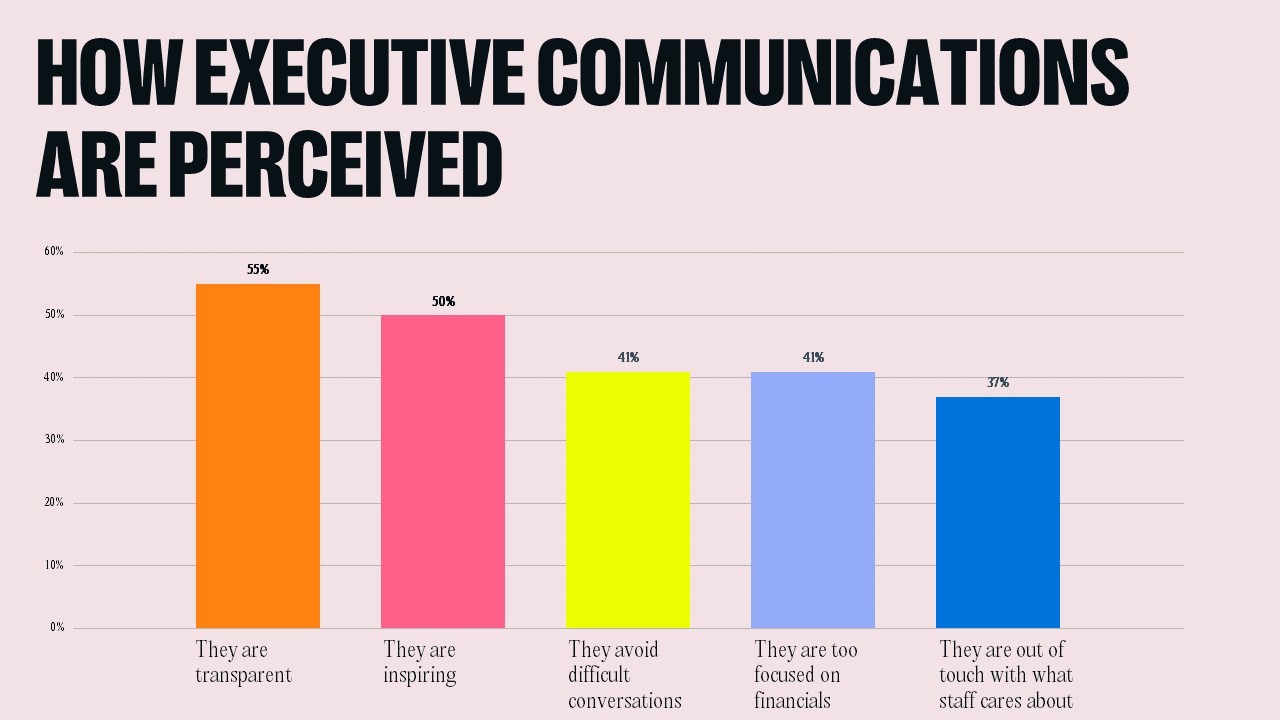L'importance des stratégies de communication interne et de marque pour les cadres

Articles suggérés
Sur des sujets similaires
Les dirigeants et les cadres d'entreprises ont toujours été observés à la loupe. Aujourd'hui, cependant, ce microscope est amplifié, en particulier en interne. Et les avis sont partagés quant à l'efficacité de la stratégie de communication interne des dirigeants.
Nos collègues de SHIFT Communications ont mené une enquête en ligne en avril 2023, auprès d'une population générale d'adultes américains sélectionnés. Sarah Babbitt rapporte les résultats.
L'article est en anglais.
———
CEOs and top company executives have always been under a microscope. Today, though, that microscope is magnified, especially internally. And people are split on how executives are doing with their internal communications strategy.
60% of people said executive teams are sincere in their communications, but just 53% said they prioritize internal communications enough in a new survey we ran.

Why executive communications are being scrutinized.
There are a few reasons why workers are more fixated on internal executive communications:
- Financial pressures have increased, and executives are being watched more closely for cues around business health.
- With a more complex set of headwinds (social, economic and political) than in previous generations, there’s greater expectation for leaders to respond and lead.
- In the face of greater financial demands, increased layoffs and turnover, and residual feelings of disconnect due to remote work, many business cultures are self-destructing (or already have).
There is a general sea of negativity around all of us. It’s incredibly easy for an executive to be personally associated with this zeitgeist and for their personal brand to become entangled in it.
How to boost internal executive brand.
Without an insanely tight employee engagement and internal communications strategy in place to respond to these shifts, executives are exposing themselves—and their companies—in a significant way. These are some of the biggest takeaways from our data, followed by tips on how you may need to communicate differently.
 Exhibit more personal and organizational humanity. Personality-forward, empathetic and emotionally invested (and expressive) executives tend to carry important messages and stories in a more compelling way. It’s great that 60% say their executives’ communications are sincere. Keep finding ways to build in personal anecdotes, musings and emotional connection.
Exhibit more personal and organizational humanity. Personality-forward, empathetic and emotionally invested (and expressive) executives tend to carry important messages and stories in a more compelling way. It’s great that 60% say their executives’ communications are sincere. Keep finding ways to build in personal anecdotes, musings and emotional connection.
Don’t avoid difficult conversations—41% of our survey respondents said their executives do. But do be highly intentional about how you frame challenges and setbacks to ensure your messages land the way you want them to.
It’s key to find the right level of transparency and to put challenges and criticisms into context. That means normalizing some of these “challenges,” as this Harvard Business Review article smartly suggests, but also offering action plans for any fallout.
Generate energy. Find ways to uplevel the delivery and content of communications. Just half of our survey respondents said their executive team’s communications are inspiring!
Revise your messaging pillars to create more opportunities to rally people around the mission and vision. Share things, big and small, that will build excitement, demonstrate follow through on strategic plans and show momentum.
Bring internal communications external. Use the weight of your external (social media) platforms to authentically celebrate your people and company. See some of our favorite examples here. Create processes to uncover opportunities to engage them. Then boost them up in a strategic way by tying their contributions to the company narrative, mission and values.
Many leaders have already recognized the need to re-examine their internal communications and engagement approach. Fewer are really prioritizing the employee audience through internal and external communications.
SHIFT conducted the online survey in April 2023, with a general population of U.S. adults screened for employment.
This article was initially published by our sister company SHIFT Communications on SHIFT Insights.
——— Sarah Babbitt est vice-présidente, Marketing interne, chez SHIFT Communications, société sœur du Cabinet de relations publiques NATIONAL

